社会及文化的度量:景观设计中无形效益的测衡
2015-11-11撰文美国艾伦戴明
撰文:(美国)M.·艾伦·戴明
翻译:税梦
社会及文化的度量:景观设计中无形效益的测衡
撰文:(美国)M.·艾伦·戴明
翻译:税梦
来自伊利诺斯大学的一支研究队伍针对风景园林基金会2013年案例研究调查项目(CSI)下的3个案例——均是位于美国中西部的公共空间——进行了考察和汇报。纵使无形社会效益和可持续性之间存在着明显的关系,衡量这种无形效益的难度和挑战依然巨大。本文描述和评价了文化社会研究中的问题、研究方法,以及研究队伍从案例中获得的发现,同时针对该案例研究调查项目(CSI),关于优化其对社会文化效益的衡量步骤提出了建议。
案例研究策略;景观无形效益;景观设计评价;社会文化效益度量;风景园林基金会;定性研究方法
1 介绍
2013年夏天,一支来自于伊利诺斯大学香槟分校的研究组为风景园林基金会下的案例调查研究项目(CSI)建立了3个案例研究。其对应的3个场地均坐落于美国中西部靠北的区域:位于印第安纳波利斯(美国印第安纳州首府)附近的卡梅尔克雷中央公园,位于安阿伯市(美国密歇根州)的安阿伯市市政中心,以及位于底特律(美国密歇根州)的米利肯州立公园二期(低地公园)。3个案例在某种程度上有着相似性——它们都是公共景观空间;各自都作为所在社区的经济驱动力;都提供了重要的生态系统服务(尤其是雨水径流的保留和过滤);各自都在“棕色地带”或是后农业场地上建立起或是修复了多样的生态环境;同时3个案例也都反应了各自社区对于被动性和主动性娱乐的需求。
针对具体的案例,风景园林基金会的研究人员们需要详细指出设计中的构成要素,同时还要衡量景观的使用效益。然而,地球物理因素的衡量和社会文化因素的衡量之间存在着很大的差异。雨水径流的加仑数和碳排放量的测量都相对程式化,同时风景园林基金会的“效益工具箱”也为方便计算提供很多有用的工具①。采用不同的后期维护手段带来的益处也可以根据省掉的花销和人力来评估。研究人员还可以计算出由新的景观微气候带来的温度变化,或是被修复及重新引入的动植物物种的数量,等等。
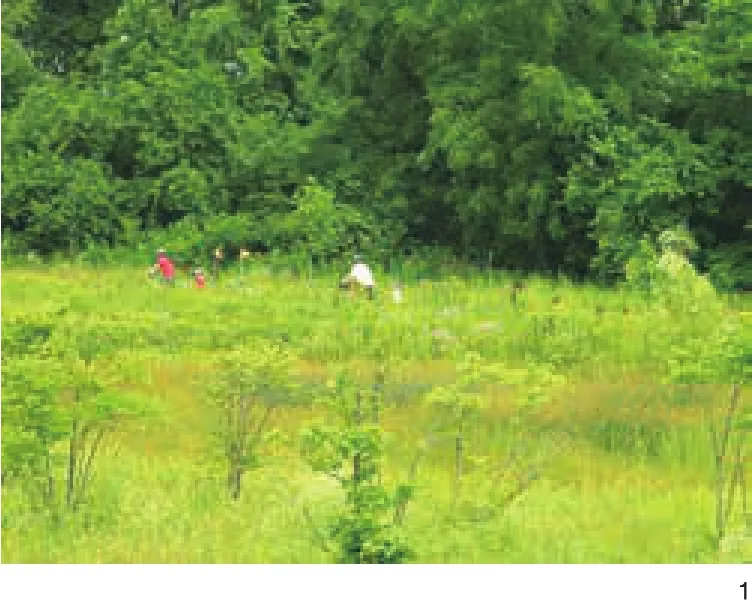
1 卡梅尔克雷中央公园。邻近自然的无形效益(照片由保罗·利特顿提供,拍摄于2013年7月)Carmel Clay Central Park. Intangible benefits of near nature (photo courtesy of Paul Littleton, July 2013).

2 在一片人工栖息地里孩子们正在和他们的父亲观察鸭子。卡梅尔克雷中央公园环礁湖(照片由保罗·利特顿提供,拍摄于2013年7月)Children with their father observing ducks in constructed habitat. Carmel Clay Central Park Lagoon (photograph courtesy of Paul Littleton, July 2013).
一个地方的受欢迎程度可以相对容易地进行量化,例如可以通过调查一个场地不同季节的使用人数或者调查对它提供的教育娱乐项目、业务的购买人数,再或是通过考察其他可以反映公众参与度的社会效益。的确,到2014年夏天为止,风景园林基金会网站上发布的82个案例研究摘要中的70个都表示了其与社会效益之间的某些联系,包括:娱乐和社交价值、文化遗产的继承、公共健康和安全、教育价值、噪音缓解、粮食生产、视觉景观质量以及其他的社会效益。但是应该采用怎样一种标准和度量单位来评价一个景观设计对于一个地方的场所性的定义或是象征意义的赋予呢?应该如何恰当地评价牵系一个场所的荣耀感和依恋情绪?又应该怎样衡量一个邻里社区社会承载力的增长?又或是它唤起的希望和责任,激起的公民利益的辩论,以及一个场所在民主进程中扮演的角色?再或是对可持续行为在家庭单位上学习和采用的激发,甚至是家庭凝聚力的创造(图1)?纵使作为社会文化效益的一部分,这些影响被频繁地提及,但是如何使些离散的效益得到有效地评估呢?本文就记述了伊利诺伊研究组在参与案例研究项目过程中面临的如此以及其他的一些挑战。
2 无形效益的衡量
在分配给伊利诺伊研究组的每一个研究案例里,方案设计师和客户都希望设计最终能实现一定的社会和文化效益,例如为社区带来社会承载力以及跨文化的理解和包容,而这些对于公共景观来说都主要是一些离散和无形的效益。在商业语汇中,无形效益被定义为非货币的或者是主观的犒赏。非物质文化遗产被联合国教科文组织定义为关乎文化的“实践,象征,表达以及知识和技能”,同时还包括对一个社会的文化产生协助意义的场所(《非物质文化遗产保护公约》,2013)。②无形暗示着社会的建构、突变、无常以及动态的运转,而非静态的结构特性。
无论这种无形作为一种因素在研究中的任何地方出现,都能够造成特殊的理论和操作上的挑战,呼吁创造力和精妙的技巧来做出回应。由于用于一些重要的无形效益的特定度量法对于伊利诺伊研究组来说,在所给的时间框架下存在应用上的困难,这导致了在我们最终的风景园林基金会(LAF)案例研究中它们被放在了相对次要的位置。然而,这并不意味着无形效益对于风景园林基金会(LAF)的案例研究调查项目(CSI)的成功不具有至关重要的影响,也不意味着该项目在可持续发展的投入中,无形效益没有扮演着关键的角色。
在过去的20年里,许多的风景园林研究活动都以可持续发展理论为纲领。最初被设定为一个犹如三腿凳的涵盖了生态、经济以及社会平等的可持续发展概念,正在逐渐被认为需要第4个辅助理念,也就是美学的支撑。正如艾丽莎白·梅耶(Elizabeth Meyer)所写道的,“沉浸式的美学体验可以引起对环境的重视、移情、热爱、尊重以及关心。”(2008,7)换句话说,没有了“对环境的重视、移情、热爱、尊重以及关心”,实现长久的生态可持续性便没有丝毫可能。(纳索尔 ,1995)。③
在实证性研究当中,无形和主观通常会造成方法论上的困难;与此同时,主观也可能会产生十分重要的美学认知和判别力,从而将研究引至新的调查和评估的疆域。对于任何一个想要完全理解景观设计的人来说,客观(定量的)和主观(定性的)注定是两个相互依赖的认知论。即便众所周知的,个体的态度和认知难以量化,但通过类似于视察,问卷调查,计数以及分组观察等手段,量化集体态度和认知应该是相对容易的。而这些手段都会在伊利诺伊研究组完成的3个案例研究中得到阐述(见后文)。
然而,在被研究人员和客户看作的社会文化效益,以及——考虑到时间和空间上的运筹限制——研究组可以收集测量的资料之间,存在着一些差异。④的确,在我们的案例研究过程中,主要命题关乎的是时间的重要性:风景园林基金会的案例研究调查项目赋予数据收集分析的时间框架是3个月——从5月至7月。但是,为了发展起一个可靠的社会研究的视角,基线数据需要在景观设计的施工前,期间以及多次在施工结束后进行收集。换句话说,也就是为了得到有效的结论,视察,问卷调查,采访以及其他评估手段都需要被反复多次进行。
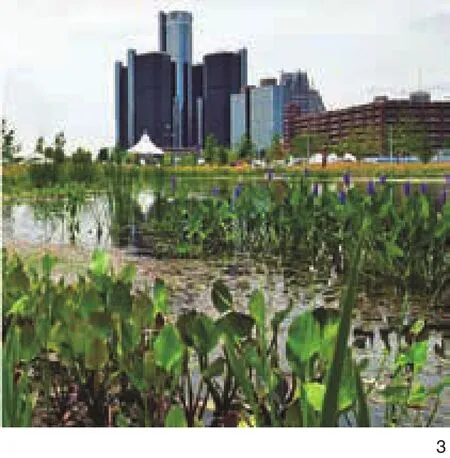
3 底特律市中心景象,穿过米立肯州立公园向西看去(照片由史密斯集团提供,拍摄于2013年)View of downtown Detroit, looking west across Milliken State Park (photograph courtesy of SmithGroupJJR,2013)
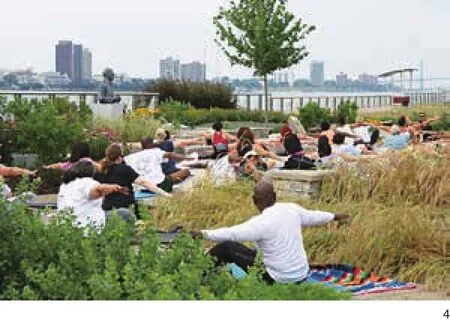
4 米立肯州立公园里的瑜伽课,靠近Stroh纪念园(照片由密歇根州自然资源部提供)Yoga class in Milliken State Park, near the Stroh Memorial(photograph courtesy of Michigan Department of Natural Resources)
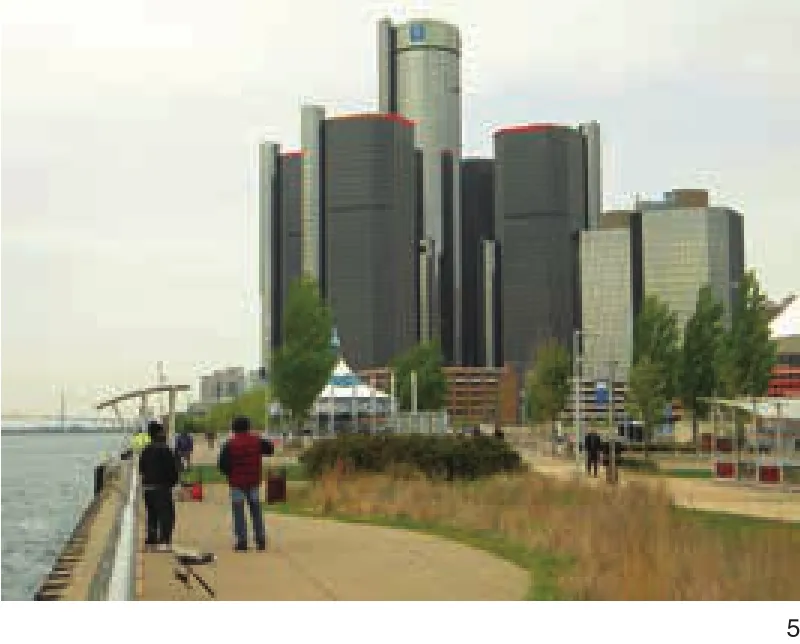
5 底特律沿河区的当地垂钓活动(照片由保罗·利特顿提供,于2013年5月拍摄)Local fishing at the Detroit riverfront (photograph courtesy of Paul Littleton, May 2013)
2.1 卡梅尔克雷中央公园
卡梅尔克雷是一个邻近印第安纳波利斯,印第安纳州的首府城市,北部的富裕郊区小镇。为卡梅尔克雷中央公园所做的案例研究(戴明和利特顿,2013c)为那类较容易观察和测量效用的景观提供了一个标准的范例。我们记录的该公园产生的效益中包括雨水径流、洗涤水的处理、带动的参观人数、节省的维护资金、产生的收益、几英里的新增的绿径 、提供的教育项目等等。
在和公园及娱乐主管马克·维思特米尔(Mark Westermeier)的谈话中,我们了解到,对于这个公园,他非常珍视的一个目标是创造“童年记忆”,一个货真价实的无形社会效益。⑤当然,孩童和成人在通过与附近自然的接触中获得的积极影响已经被许多学者在理论领域提及(卡普兰和卡普兰,1989;霍,2010;卢夫 ,2005),并且维思特米尔坚信,年少时与自然的接触以及对其运行幻变的感受在情绪、肢体上和教育层面上都充满意义的。但我们应该如何量度记忆呢?
考虑到极其有限的在场地上花的十几个小时,或是整个基地调查几天的行程,得出可行的关于度量孩子在一个新建的人工栖息地上观察鸭子所产生的无形效益的策略难免会显得概略粗浅(图2)。我们“知道”,父亲、孩子以及鸭子构成的无形的三角因素之所以重要,恰恰是因为在未来它们可能以多种不同的形式呈现出其影响:一种场地守望者对这片场地以及其中栖居的其他生物产生的依恋情绪;一段与兄妹共享的回忆;多年后生物课上的一个参考点;一个未来有力的对荒地保护的实证和宣扬,或者仅仅是作为一段关于公园的动人回忆,日后年复一年地唤起去公园走走的念头。仅仅通过一次造访,或者是依凭其在一个季节里的姿态,就想用这样的语汇来评价明显的益处将会是一件很困难的事情,因为这种益处所指的是一种相互关系——一个暗示着其价值是随着时间的流逝而得到不断积累的概念。这个概念直接挑战了通常用于案例研究调查项目(CSI)的快速场地评估的局限。或许更重要的是,它也在有效程度上质疑了通常在职业工作室里所做的场地分析,在其中,除了当地的案例,许多“场地分析”都是在毫无实地走访或是任何其他形式的直接观察的情况下完成的。
2.2 密歇根州底特律米利肯州立公园
坐落于底特律市的这个案例研究主要是集中在米利肯公园的2期,密歇根州的第一个市区州立公园、低地公园上。底特律市是一个人口逐渐减少的后工业城市,正处在对当下落后经济和破败形象都勉强维持的状态。米利肯州立公园的案例研究(戴明和利特顿,2013b) 呈现出一系列底特律的新沿河景观改善环境的方式,包括:雨水径流的过滤以及污染物的消除;鸟类和植物的新栖息地的提供;新公民收入的创造;几英里的与更大的交通系统相连的新绿径的打造;新教育项目的衍生,等等(图3)。
在底特律市中心,米利肯州立公园的景观改善所产生的效益曾经被指望着具有扭转局面的效果,带来巨大的经济影响:据估计,底特律滨水区将每年迎来300万的参观者,新的2期公园会延生并连接起哈特广场、米利肯州立公园以及向东部和北部更远处的港口区。如果这些期望中的游客中的每一个仅仅是在每次造访这里时有上几美元的消费——乘积式的效益将会是巨大的。同时,因为低地公园毗邻GM复兴中心,底特律市中心区大约1/3工人的居住区,这个新公园将会在视线联系和空间位置上都与一个亟待服务的群体享有邻近(图4-5)。
传统的景观效益在米利肯州立公园案例上可以轻易通过收集或者过滤的水量以及产生的资金来评估。同时,另一个重要的景观效益是经济上的:作为一块坐落于面向更大的密歇根州公园系统的入口中心区内的场地,整个公园系统都等待着从米利肯公园2期的成功中获得经济上的增长。 我们的研究小组不可能以任何明确的方式来衡量这种效益。然而,由于米利肯公园同样为周围几个开发地块提供生态系统上的服务,因此公园设计师和管理者寄希望于底特律市中心的开发商,会因其优良的视野和削减了的在排水、滤水上投入的资金所吸引而在周围投资。那么我们应该如何衡量一个设计的开放空间所具有的转变力的价值呢?这种转变力可以作为城市发展的催化剂以及帮助一个凋敝的区域重拾希望。
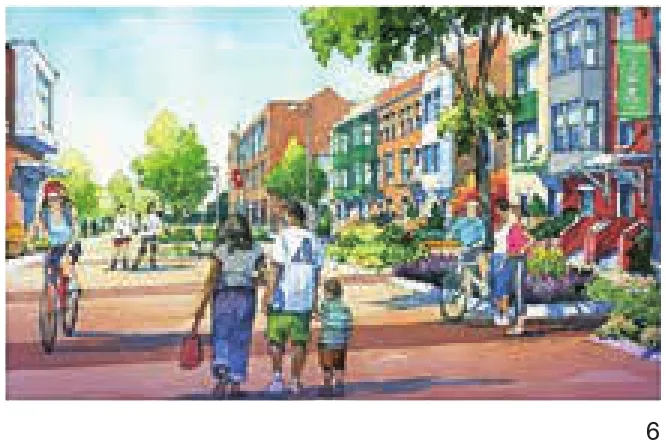
6 城市规划协会,匹兹堡,宾夕法尼亚州,底特律市中心米利肯州立公园附近综合用途发展区效果图(麦克康柏克·巴伦·萨拉泽制作)(图片由雷德尔于2013年提供)Urban Design Associates, Pittsburgh, PA. Rendering of mixed-use development (McCormack Baron Salazar)adjacent to Milliken State Park in downtown Detroit (Image source: Reindl 2013)

7 安阿伯市市政中心(照片由斯密斯集团提供)Ann Arbor Municipal Center (photograph courtesy of SmithGroup/JJR)
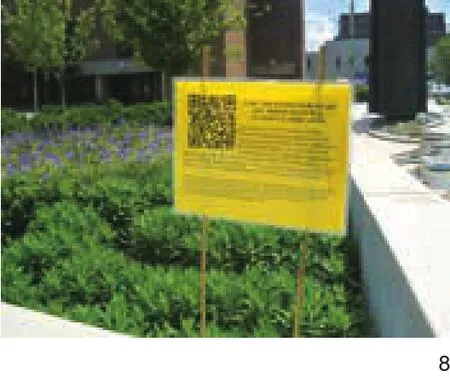
8 关于安阿伯市市政中心调查的二维码(照片由南希·斯通提供,拍摄于2013年7月)QR Code/Survey at Ann Arbor Municipal Center(photograph courtesy of Nancy Stone, July 2013)
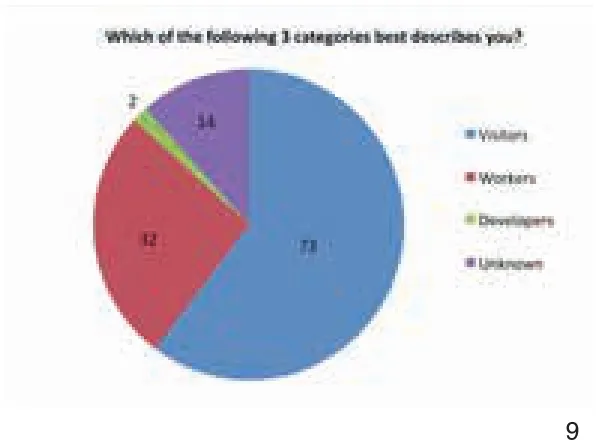
9 安阿伯市案例调查中的调查问卷(问题2和3);图表由保罗·利特顿于2013年设计(图表中问题及选项:以下3个类别哪个最好地描述了你?参观者,雇员,开发商,不明)Ann Arbor Questionnnaire (Q#2 and 3); diagram by Paul Littleton 2013
就在底特律市宣布破产的同一周,一笔5 500万美元的住宅开发资金在毗邻公园的场地上启动(雷德尔,2013;图6)这是否可以作为新景观带来的社会效益的一个直接衡量证据呢?不。那这个发展契机又是否是由新公园导致的呢?不可能仅仅依赖公园自身,而是整个底特律都在寻求对公众感知的转变,在向世界发出底特律已经做好了迎接新投资的准备的信号的努力中,米利肯公园2期的完成提供了一个有力的实证。
如此一个意识上的面向希望和再投资的转变是一个强大的无形社会效益,这毋庸置疑,相比之下,我们遇到的研究问题是如何去度量以及“证明”它。我们采取的方法是调查当地媒体以获得同步的事件讯息以及附近的开发状况(例如,报刊故事、社会事件、房地趋势和投资预测)。这样我们便也可以整理出很多证据,用来支撑在这个新的公共景观中的,一系列由无形效益(希望、信任、机会、能量、荣耀等)导致的有形效益(例如房地产投资,增加的交通量和商业活动以及减少的犯罪率,等等)。
2.3 安阿伯市市政中心
安阿伯市市政中心(AAMC)是一个在已有的市法院和拘留所基础上进行的扩张和革新项目。它同时也被设计作为行政部门对可持续设计理念坚决执行的彰显。为AAMC所做的这个案例研究(戴明和利特顿,2013d)中展现了好几个这类高度工程化的建筑景观所能呈现的生态效益,其中包括:滞留和吸收雨水;屋顶绿化降低建筑供热和降温开销;运用本土植物以过滤收集自屋顶和人行道的雨水;以及一系列的户外设施例如座椅、指示牌以及雕塑(图7)。
由于合作单位——安阿伯市保护设计论坛的一些声明带来的激励作用,我们创造了一个可以调查一些社会效益的契机。在这个方案的概述中,设计师表示这个设计帮助提高了实践环境保护的意识从而以教育民众,并且具体场地上的特定雕塑也同样起着提升环境意识的作用。而意识、教育,这些重要的社会效益应该如何被衡量?
我们认为针对这个问题最好的数据应该来自于个体的回应。为了衡量社会效益我们所采取的措施是来自于“调查猴子”网站上提供的一套免费简短的基础调查流程。 我们的调查获得了来自安阿伯市公共事务联络部门的协助,他们通过在公共发布平台上以及电子邮件的虚拟社区中广布我们的调查,以及在AAMC周围广泛安置印有快速在线调查二维码的公告来使大众参与其中(图8)。调查大约于7月1号激活,并在接下来的3个星期中收集到了超过120个受访者的回复。
在我校内部审查委员会(IRB)要求的标准的提案(关于受试人的保护)之后,我们调查问卷的第一个条目便是知情同意的页面,解释了参与调查的风险和益处。接着我们便要求受访者说明他们对场地的熟悉度(雇员或是参观者),以及对各种公用设施用途等的熟悉程度,同时我们也询问他们认为这个方案是如何对安阿伯市造成的影响的,以及他们是否会考虑将类似于雨水管理的技术使用到自己的家庭院落,或是否愿意将其沿用到其他方案中。调查的3个主要参与人群分别是市政府的雇员、参观者和市政中心的公共使用者,以及在此执行公务的职业设计师或是开发商。这些人群对于之后的对调查结果的交叉引用非常重要(图9)。
接着,我们就以下问题通过一个5度的等级划分来衡量人们的感知和态度:“你是否同意这个场地设计的功能和吸引力提升了安阿伯市市政府的公共形象?”以及“你是否同意一个雨水管理系统……可以作为安阿伯市的未来发展的一个模型?”通过这些问题,我们得到了非常有力地描述了人们的偏好、态度、认知甚至是担忧的数据。然后,我们便比较实验了不同的手法(例如柱状图、饼状图等)来力图最好地表现数据背后的重要模式。
然而相比之下更有趣的是那些针对好几个我们提出问题的定性回答:大约有1/3的受访者(35个左右)留下了大段的评论——详尽地表达了对安阿伯市市政中心的态度,有支持有反对。从这些定性的回答中,我们可以清晰地看到大众评价在这个项目上的分歧。在我们于8月发布在的风景园林基金会博客上的一篇名为“新兴的生态,别样的美学,和公众的声音”(2013)中,我们试图初步解释这些回答:
从某种意义上说,这些案例中的每一个都试图通过将一切呈现于参与者面前来教育他们有关于水利运作过程的知识。可问题是,并不是所有的人都明白他们所看到的。在研究方案的可量化的景观效益背后,我们觉得还存在其他的待考量的社会影响。我们享受设计师们和客户们表达出来的对这些场所的热情;我们也遭遇到来自很多普通市民们对新的景观空间表达出来的困惑,这些体现了对自然的新的认识的设计让这些市民们产生一种矛盾的情绪(戴明和利特顿,2013a)。
在最终发布在案例研究网页上的文本中,我们记录了使用到的手段和技术,但没有对我们的发现做过多的主观评价。相比之下,我们利用风景园林基金会(LAF)的博客,来分享一些我们收集到的对不同的大众意见有代表性的回答。值得赞扬的是,安阿伯市的居民无疑对本市的公共空间抱有极大的关心。方案的支持者们如是说: “设计师们完成了一个优秀的设计”,“这个设计是一个相当好的范例,当我们日后想要试图说服私人开发商考虑采用对环境影响小的开发技术的时候,这个设计可以很好地被用来展示该技术一些具体的特征。”“市政中心的部分区域为使客户考虑在他们的自己的建筑项目中运用类似形式提供了一个很好的范例。”
反对者写到:“如果市政厅试图建立起一个范例的话,那么他们失败了。”
“他们给人一种想要看上去更聪明而不是更包容的印象……他们刻意为之而非让一切从真实的大众需求中发展起来”,“这些所谓的生态特性完全没有提升我的建筑体验,同时也完全没有被非常好的在设计中运用呈现出来以提高人们的环境意识……整体布局剥离了建筑前及屋顶上的公共空间应有的公共使用……好像市政府并不真正希望公众能在市政厅周围活动一样。”
3 结论
研究小组决定不在终稿里包含那些具有争议的内容,而是主要汇报描述性的数据:93%的市政雇员以及63%的参观者赞成雨水管理的相关特性可以被用作于安阿伯市未来发展的模型。在被问及到他们对户外面向公共用途的设施的关心程度的时候,77%的市政厅里的雇员表示他们至少是在某些情况下使用这些设施或是认为它们有用。并且,在受访的人群中,有1/3的人表示他们将会考虑将相似的(尺度可调整的)措施运用到他们自己的居住或商业地产上。
然而,这些有争议的和相对更实用的答复揭示了两个争论点:1)在选择公共艺术家及他的作品的时候采用的程序;2)设计师在设计安阿伯市市政中心时所用的象征性语言。一些特定的设计语言激起了一种关于自然价值和视觉价值争论的拟仿;它同时也在拟仿公共空间的可达性和使用效率的争论;花费和收益的争论;关于一个社区在选择自己的艺术家和设计师的时候,怎样被赋予权力的争论——这些皆是正当并极为重要的讨论。因此虽然对通常的看待公共空间的视角发起挑战可以是有价值并且有回报的,这似乎是一件很清楚的事情,但是真正的执行还是可能会充满忧虑和张力。而这并非是件坏事。表达的自由、公共进程和辩论为社区成员提供一个发声的机会,这些都属于风景园林设计及城市规划所带来的最为重要的社会文化效益的范畴。留给我们的,只是找到足够有力的手段去“证明”它们。
最后,调查组总结出的是,在衡量景观设计中的无形效益时,或许时间是最为本质和重要的因素中的一个。因为风景园林基金会案例研究调查项目(LAF CSI)的目标的一部分内容就是,在学年之间短暂的间隙里完成一段调查工作,而这必将是限制重重。然而,如果有一个可以将现有项目扩展成其他形式的机遇,便可以提出以下一些建议:
(1)候选案例的设计师以及客户应该为社会调查(在一定时间间隔下可重复的)提供或建立起更完善的基线数据;
(2)调查组们应该在对无形效益进行衡量之前对大维度的时间语境(历史的以及发展的时间框架)以及同步的时间语境(当下的事件及态度)进行研究;
(3)风景园林基金会应该为发挥相似效益的案例进行整体的,统一模式下的分析,以使得特定的在这些设计中被使用的设计元素能够更好地与它的公共使用,价值和意义,以一种有系统的方式关联起来;
(4)风景园林基金会案例研究调查项目的顾问或者调查组咨询人员应该为设计师、客户、研究组在定性的或是社会调查手段及机制上提供策略上的帮助,而这些活动需要先于案例研究调查项目的启动。
这些步骤其实都是想说明,很多风景园林基金会案例调查研究项目想要寻求的,重要的社会文化研究提案,或许在一个有别于当下状况的时间和空间尺度下,能够得到更成功地设计和实施。同时,在现存的项目结构下,始终还存在很多收集信息的机会,以支撑无形效益。
致谢
这3个案例的设计团队以及客户联系人都非常地慷慨并提供了不可估量的协助与支持。Carmel Clay中央公园的项目联系人其中包括来自史密斯集团(芝加哥)的联络人帕特里克·布劳利,以及为社区目标还有社区发展愿景投入颇多深刻见解的公园主管马克·维思特米尔和副主管迈克尔·克里青。米利肯州立公园二期的设计联系人(底特律市),来自史密斯集团(安阿伯市)的保罗·伊凡奥夫和鲍勃·多伊尔,以及我们的社区联系人包括我们米利肯州立公园和港口区的参观引导人娜塔莉·雷,还有底特律沿河保护区的引导人凯伦·斯洛特-杜佩里。至于安阿伯市市政中心,我们的设计联系人是来自于保护设计论坛(安阿伯市)和的帕特里克·朱德,以及特别感谢InSite设计工作室奎恩·伊凡斯建筑师事务所(安阿伯市),还有由德国戴水道设计公司提供的水上雕塑;我们的客户联系人是来自于安阿伯市的公共通信联络部门的南希·斯通。景观建筑基金会的琳达·艾希莉、希瑟·惠伊洛和凯瑟琳·柏吉思都已出色的编辑和导师的身份参与到整个过程当中。税梦(Meng Shui)也在后来杰出地完成了本文的中文翻译工作。最后,作者特别鸣谢案例研究调查项目的研究助理,异常杰出的保罗·利特顿(伊利诺伊大学2015年景观建筑研究生),他在2013年的春季和夏季无比投入地贡献了他的时间,深刻见解以及组织能力,如果没有努力,这个项目不可能完成。
注释
①景观建筑基金会效益工具箱为案例调查研究(CSI)的研究组的各项工作,景观设计从业人员以及学生都提供了一个无价的资源,并且在不断地更新进步。然而,截止至2014年夏天,工具箱中只包含了(3个)社会效益计算器,相比之下,用于经济效益的计算器有13个,水体的有17个,碳排放、能源和空气质量的有14个。其他类别的效益包括土地(4个工具);材料和废弃物(3个工具);以及栖息地(1个工具)。
https://lafoundation.org/research/landscape-performanceseries/toolkit/
②联合国教科文组织对于无形的定义指向一种持续的变化:“...被社区,群体,以及在某些情景中,个人认为是他们的文化遗产中的一部分。这种无形的文化遗产,在一代代的传递中,不断地被社区或群体,因为与他们所处环境的对话,与自然和历史的互动,再创造着,而这给予了他们对自己身份和对文化连续性的感知,从而也加深了对文化多样性以及人类创造力的尊重。”
③对可持续性理论的评判可能会因此与对非物质文化相关政策的评判并行,很大程度上是因为一种倾向于“抵抗削减了文化属性[景观]的关于遗产[可持续性]的讨论,我们试图去反驳这些概念对于物质网络在社会生活中扮演角色的偏袒。”(Byrne 2009, 230)
④在案例调查研究项目(CSI)中的方法论上遇到的限制主要都是操作上的而非意识形态上的。虽然CSI的中心指导理论是可持续性,项目管理员却在遵从可持续性概念的新兴定义,新兴维度的前提下,在接受很多新技术上面,展现出大胆,灵活和深刻的洞察。同样,CSI的项目员工及董事会成员所提供的研究指导,也对景观设计的不同价值观和评价标准,展现出极大的包容和支持。
⑤调查组对Mark Westermeier的采访,2013年5月10日。
1 Introduction
During the summer of 2013, a research team from the University of Illinois, Urbana-Champaign, developed three case studies for the Case Study Investigation program (CSI) of the Landscape Architecture Foundation. All three sites were located in the northern section of the American Midwest: Carmel Clay Central Park near Indianapolis (Indiana); Ann Arbor Municipal Center in Ann Arbor (Michigan); and Milliken State Park, Phase II (Lowlands Park), in downtown Detroit (Michigan). All three projects shared certain dimensions in common—they were all public landscapes; they each served as economic drivers for their communities; they provided important ecosystem services (particularly stormwater runoff retention and filtration); each established or "restored" diverse ecologies on brownfield or post-agricultural sites; and each of them refl ected community desire for passive and active recreation opportunities.
Research Fellows of the Landscape Architecture Foundation (LAF) are asked to detail key components and measure performance benefits for specific designed landscapes. There are significant differences, however, between the work of measuring geo-physical factors and that of socio-cultural factors. Measuring gallons of storm-water runoff collected or tons of carbon sequestered can be relatively formulaic, and many useful methods for calculation are provided in the LAF Benefi ts Toolkit.①The benefi ts of adopting alternative maintenance practices can be estimated in how much money or labor is saved. Researchers can calculate degrees of temperature modulated by new landscape microclimates, or the numbersof new species of animals and plants restored or reintroduced, and so on.
It can be relatively easy to quantify the popularity of a site in terms of its seasonal users and/or subscriptions to recreational or educational programs offered there, or other social benefits related to participation. Indeed, by the end of summer 2014, 70 of the 82 published case study briefs published on the LAF web site claim some combination of social benefits, including:recreational and social value; cultural heritage;public health and safety; educational value; noise mitigation; food production; scenic quality; and other social benefits. But what yardstick or unit of measure can be used to assess the qualitative narrative or symbolic value of a designed landscape? How can pride of place or place attachment best be evaluated? How about the increase in the social capacity of a neighboring community? What about hope? stewardship?civil debate? engagement in democratic process?learning and adopting new sustainable practices at home? family togetherness (Figure 1)? Despite the frequent mention of these results as social and cultural benefi ts, how are such discursive benefi ts to be measured? This essay describes these and other challenges that the Illinois research team faced during the Case Study Investigation program.
2 Measuring Intangible Benefi ts
According to the project designers and clients, each of the case study projects assigned to the Illinois team purported to achieve certain social and cultural benefits, such as contributing to community social capacity and cross-cultural understanding, which are principally discursive or intangible benefits of public landscape. In the world of business, intangible benefits are defined as non-monetary or subjective rewards. Intangible heritage is defined by UNESCO (Convention for the Safeguarding of Intangible Cultural Heritage,2003) as the cultural "practices, representations,expressions, knowledge and skills" as well as the supporting sites of cultural production for a society.②Intangibility implies social construction,mutation, ephemerality, and operational rather than structural characteristics.
Wherever intangibility is a factor in research,it can pose special intellectual and practical research challenges that demand creativity and subtlety in response. Because specific metrics of some important intangible benefits proved difficult for the Illinois team to collect within the time frame allowed, they remain underreported in our final LAF case studies. However, this should not be construed to mean intangible benefits are not critically important to the success of the LAF CSI program or its commitment to the values of sustainability.
For the past two decades, much research activity in landscape architecture has been framed by the theory of sustainability. Originally diagrammed as a three-legged stool comprising the three ‘E’s (ecology, economy, and social equity);sustainability is increasingly thought to need a fourth appendage—aesthetics. As Elizabeth Meyer has written, "immersive, aesthetic experience can lead to recognition, empathy, love, respect and care for the environment" (2008, 7). In other words,without "recognition, empathy, love and respect for the environment," lasting ecological sustainability is not even a dim possibility (Nassauer 1995).③
In empirical research, intangibility and subjectivity typically poses methodological difficulties; at the same time, subjectivity also may generate valuable aesthetic awareness and judgments that lead to new areas of investigation and valuation. For anyone seeking a complete understanding of built landscapes, objectivity(quantitative) and subjectivity (qualitative) appear to be necessarily codependent epistemologies. But although individual attitudes or perceptions are notoriously diffi cult to quantify, collective attitudes and perceptions should be easier to measure by way of tools such as surveys, questionnaires,counts, and group observations. These methods are illustrated in the three case studies completed by the Illinois team (below).
There were, however, several differences between what researchers and clients identified as social and cultural benefits, and—given the logistical constraints of time and space—what evidence the research team was able to gather or measure.④Indeed, the major theme that emerges from our case study experience is about the importance of time: the window of time structured into the LAF CSI program for collecting and analyzing data is effectively three months—May through July. However, to develop reliable perspectives from social research, baseline data need to be gathered before, during, and several times after the construction of a built landscape. In other words, to yield meaningful results, surveys,questionnaires, interviews, and other evaluation techniques must be planned for repeated iterations.
2.1 Carmel Clay Central Park
Carmel Clay is an affl uent suburb just northof Indianapolis, the capital city for the state of Indiana. The case study produced for Carmel Clay Central Park (Deming and Littleton 2013c)offers a fairly standard example of the types of landscape performance that can be easily observed and measured. Park benefi ts we reported included stormwater runoff; greywater treated; numbers of visits generated; maintenance costs saved; revenues generated; miles of new trails created; educational programs offered; and so on.
In conversations with Mark Westermeier,director of parks and recreation, we learned one of his cherished goals for this park was to create "childhood memories," truly an intangible social benefit.⑤Certainly, the benefit to children and adults in contact with near nature has been theorized by many (Kaplan and Kaplan 1989;Kuo 2010; Louv 2005), and Westermeier strongly believed that youthful contact with nature and its processes was of value both emotionally as well as physically and educationally. But how do we measure memories?
Given the time constraints of a few dozen hours spent on site, or a few day trips to the site, available strategies for measuring the intangible benefits of children observing ducks in a newly constructed habitat seemed sketchy at best (Figure 2). We "know" the intangible triangulation between dad, kids, and ducklings is important precisely because it may be manifested in the future in a hundred different ways: as a stewardship attachment to this place and its nonhuman residents; a memory shared between siblings; a reference point for biology classes many years ahead; in future advocacy for wildland conservation, or simply as a memory that invites visits to other parks year after year. It can be diffi cult to measure defi nite benefi ts in such terms in a single visit, or even a single season, because the benefit is a relationship—a notion implying values that accrue over time. This notion directly challenges the limits of the rapid fi eld assessment typically performed in the context of the Case Study Investigations. Perhaps more important,it also challenges the level of site analysis that is normally performed in professional offi ces where,except in the case of local work, many sites are "analyzed" without the benefi t of any site visit or direct observation whatsoever.
2.2 Milliken State Park, Detroit, MI
The case study for Detroit focused on the second phase of Milliken Park, called Lowland Park, the fi rst urban state park in Michigan. Detroit is a depopulated post-industrial city struggling to stabilize its lagging economy and poor image. The case study for Milliken State Park (Deming and Littleton 2013b) presents a variety of ways that this new Detroit riverfront landscape performs,including: filtration of stormwater runoff and removal of contaminants; creation of new habitat for birds and plants; new civic revenues; miles of new trails connect to a larger network; educational programs offered; and so on (Figure 3).
In downtown Detroit, it was hoped, the landscape performance benefits of Milliken State Park would be transformational, with huge economic impacts: having an estimated 3 million visitors annually to the Detroit waterfront, the new Phase II park extended and linked Hart Plaza with Milliken State Park and Harbor further to the north and east. If each of those visitors only spent a few dollars here on every visit—the multiplier effect would be powerful. Also, because of its proximity to the GM Renaissance Center, housing almost a third of all workers in downtown Detroit, this new park had fantastic visual and spatial proximity to a signifi cant underserved population (Figures 4 and 5).
Conventional performance benefi ts at Milliken were easy to estimate in gallons of water collected/ filtered and dollars generated. Another important performance benefi t at Milliken was economic: as the site of a Gateway visitor center to the larger Michigan state parks system, the entire state park system stands to gain fi nancially from the success of Phase II Milliken Park. Our team was unable to measure this benefi t in any defi nite way. However,because Milliken Park also provides ecosystem services for adjacent development parcels, the hope among the park’s designers and managers was that developers in downtown Detroit would find both the visual amenity and the reduced cost of stormwater catchment and fi ltration attractive for new investments nearby. So how could we measure the transformational value of designed open space as catalyst for urban development and the return of hope to a blighted area?
In the same week that the city of Detroit declared bankruptcy, a $55 million housing development was launched for the sites immediately adjacent to the Park (Reindl 2013; Figure 6). Is that a direct measure of the social benefi ts of the new landscape? No. Did the new Park cause the development to happen? Not by itself in isolation,but the completion of Phase II of Milliken Park was arguably part of a shift in sensibilities that signaled to the world that downtown Detroit was ready for new investment.
That a shift in sensibility towards hope and reinvestment is a powerful intangible social benefi t is not in question here: rather, the research problem is how to measure or "prove" it. Our method was to search the local media (newspaper stories, social event listings, real estate trends and forecasts, etc.) to gather evidence for synchronic events and proximate developments. In this way, we could marshal evidence in support of a pattern of tangible proximate benefi ts (real estate investment;increased traffic and business activity; reduced crime, etc.) resulting from the intangible benefits(hope, trust, opportunity, energy, pride, etc.) of this new public landscape.
2.3 Ann Arbor Municipal Center
Ann Arbor Municipal Center (AAMC) is an expansion and renovation of an existing municipal courthouse and detention center. It is also designed as a demonstration of local administrative commitment to sustainable design principles. The case study for AAMC (Deming and Littleton 2013d) features several of the ecological services performed by this heavily engineered architectural landscape including: retention and absorption of stormwater runoff; green-roof reduction of heating and cooling costs; use of native plants to fi lter runoff from roof drains and sidewalks; and a variety of outdoor amenities such as seating,signage and sculpture. (Figure 7).
Motivated in part by specifi c claims made by our partner office—Conservation Design Forum of Ann Arbor—we created an opportunity to probe some questions about social benefits. The project brief prepared by the designers claimed that the design helped to elevate awareness of environmental conservation practices to educate the public and that the site-specific sculpture on site also functioned as to raise environmental awareness. Awareness? Education? How could these important social benefi ts be measured?
We decided the best unit of data would be the personal response. Our method for measuring social benefi ts was a short online survey using the basic free package provided by SurveyMonkey. The public affairs liaison for the City of Ann Arbor assisted our survey process by announcing it through a public press release, a listserv, and installing posters with a QR (Quick Response) code throughout the AAMC for members of the general public to take part (Figure 8). The survey went live about July 1st and generated over 120 responses within the next three weeks.
Following the standard protocol (for the protection of human subjects) required by our University’s Internal Review Board (IRB), the first item in our survey was an informed consent page explaining the risks and the benefits of participation. We then asked respondents to identify their familiarity with the place (employees or visitors), use of various amenities, etc., how they thought the project reflected on the city of Ann Arbor, and whether they would consider similar stormwater management techniques for their home landscapes or in other projects. The three basic participant groups were employees of the City,visitors and public users of the municipal center,and professional designers or developers who were conducting official business. These groups were important for cross-referencing the survey responses later (Figure 9).
Next, using a 5-level scale, we measured perception and attitudes in accordance with the following questions: "Do you agree that the public image of Ann Arbor’s city government has been enhanced by the site’s functionality and attractiveness?" and "Do you agree that a rainwater management system… could serve as a model for future development in Ann Arbor?" These questions generated a robust dataset describing affiliations, attitudes, perceptions and even concerns. We then explored different formats (bars,pie charts, etc) for displaying these data to express some of the key patterns.
More interesting, however, were the qualitative responses to several of our questions: as many as 1/3 (~35 respondents) wrote out lengthy comments—thorough and articulate expressions about the Ann Municipal Center, both pro and con. From these qualitative responses we were able to understand divergent public opinion on the project. In our LAF blog post in August, entitled "Emergent Ecologies, Alternative Aesthetics, and Public Opinions" (2013), we tried to make sense of these responses in a preliminary way:
"In a sense, each of these projects tries to teach visitors about hydrological processes by laying them bare to view. Trouble is, not everyone understands what they see. Behind the performance benefi ts quantifi ed for our projects we sense there may be other social impacts to be measured. We enjoyed the enthusiasm for these places expressed by designers and clients; we also encountered a level of puzzlement and ambivalence from many ordinary citizens toward new kinds of public open spaces that adopt a new attitude towards nature."(Deming and Littleton 2013a)
We wrote up the techniques we used for thefinal Case Study web page but stopped short of editorializing on our findings. Instead we used the LAF blog as an opportunity to share a few responses that were representative of the divided public opinion. To their credit, residents of Ann Arbor obviously care deeply about public open space. Supporters of the project said:
"The designers did a good job"; "It's great to be able to demonstrate these features to private developers when we're trying to encourage them to consider low-impact development techniques";"Parts of the center offer good examples to show clients considering such features in their own buildings."
Naysayers wrote: "If city hall is trying to lead by example, they are failing:"
They come across as being "smarter" vs. inclusive … They force stuff vs. letting it develop out of a genuine public want"; "these features do not improve my experience of the building and are not presented in a way that improves environmental consciousness… [T]he overall lay out removes public space in front of and on the roof of the building from public use… [as if] the city government doesn't actually want the public to be able to gather near or around the building." (direct quotes are from anonymous survey participants)
3 Conclusions
The research team chose not to include the controversy in the fi nal write-up, instead reporting mainly descriptive data: 93% of municipal employees and 63% of visitors agreed that the stormwater management features could serve as a model for future development in Ann Arbor. Asked how much they valued the outdoor amenities provided for public use, 77% of the employees at the building said they used or appreciated the amenities at least occasionally. And one-third of those surveyed responded that they would consider adopting similar (scalable) measures for their homes or commercial properties.
However, the contentious and more useful responses revealed two debates: 1) concerning the process that was used to select the public artist and the work he produced; and 2) the symbolic language of design that the designers used at the Ann Arbor Municipal Center. The design language in particular sparked an animated debate about environmental and visual values; about access and usability of public spaces; about costs and benefi ts;and also about the way a community is empowered to select its artists and designers—all vital and legitimate things to debate. So although it is clear that challenging the normative perceptions of public space can be both valuable and rewarding,it may also be fraught with tension. And that is not necessarily a bad thing. Freedom of expression,public process and debate, giving a voice to community members are all among the greatest social and even cultural performance benefi ts of landscape architecture and urban design. It only remains for us to fi nd methods adequate to "prove" it.
In conclusion, the research team learned that in measuring the intangible benefits of designed landscape, perhaps time is one of the most critical and essential factors. Because the LAF CSI program goals are, in part, to form a work experience that fits within the short gap in the academic year,it is necessarily constrained. However, given an opportunity to expand the program to other formats, several recommendations might emerge:
1) designer/clients of candidate case studies to provide (or establish) better baseline data for social surveys (repeatable at intervals);
2) research teams to study context of diachronic (historical or developmental) and synchronic (current events and attitudes) factors before measuring intangible benefi ts;
3) LAF should perform meta-analyses for groups of projects claiming similar benefits in order to correlate specific design elements with public use, value and meaning; and
4) LAF CSI advisors or research team consultants offering strategic assistance to designers/clients/research teams on qualitative or social survey methods and mechanisms even before the CSI program begins.
These steps all suggest that some of the important socio-cultural research protocols that the CSI program seeks may be more successfully designed and implemented at a different temporal or geographic scale than the program currently supports. In the meantime, there are still a great many opportunities for gathering evidence of intangible benefits that fit within the existing programmatic structures.
Acknowledgments
Design teams and client contacts for all three projects were extraordinarily generous and offered invaluable assistance. Project contacts for Carmel Clay Central Park included liaison Patrick Brawley of SmithGroup/JJR (Chicago), Park Director Mark Westermeier and Associate Director Michael Klitzing who offered deep insights into their community’s goals and aspirations. Design liaisons for Milliken State Park Phase Two (Detroit) were Paul Evanoff and Bob Doyle of SmithGroup/JJR (Ann Arbor), and our community contacts included Natalie Ray, Explorer Guide for Milliken State Park and Harbor, and Karen Slaughter-DuPerry of the Detroit Riverfront Conservancy. At the Ann ArborMunicipal Center, our design liaison for was Patrick Judd of Conservation Design Forum (Ann Arbor) and InSite Design Studio, with Quinn Evans Architects (Ann Arbor) and water sculpture by Atelier Dreiseitl; our client contact was Nancy Stone, Public Communications Liaison for the City of Ann Arbor. At the Landscape Architecture Foundation, Linda Ashby, Heather Whitlow, and Katherine Burgess served as excellent editors and mentors throughout the process. Meng Shui kindly stepped in as our superb translator. Last but not least, the author acknowledges CSI Research Assistant extraordinaire Paul Littleton (University of Illinois MLA 2015) who contributed mightily of his time, insight, and organizational skills during spring and summer of 2013. Without Paul this project would never have happened.
Notes
①The Benefits Toolkit of the Landscape Architecture Foundation serves as an invaluable resource for the work of CSI research teams as well as practitioners and students,and continues to evolve over time. As of summer 2014,however, the Toolkit showed just three (3) social benefit calculators compared to 13 for economic benefits; 17 for water; and 14 for carbon, energy, and air quality, for instance. Other benefit categories include land (4 tools);materials and waste (3 tools); and habitat (1 tool). https:// lafoundation.org/research/landscape-performance-series/ toolkit/
②The UNESCO definition of intangibility implies constant mutation: “…that communities, groups and, in some cases,individuals recognize as part of their cultural heritage. This intangible cultural heritage, transmitted from generation to generation, is constantly recreated by communities and groups in response to their environment, their interaction with nature and their history, and provides them with a sense of identity and continuity, thus promoting respect for cultural diversity and human creativity” (UNESCO 2003).
③ Critique of the theory of sustainability may thus run parallel to critique of policy in intangible heritage; largely because it is tempting to “resist the tendency of heritage[sustainability] discourse to reduce culture [landscape] to things, we try to counter its privileging of physical fabric over social life” (Byrne 2009, 230).
④ Methodological constraints within the Case Study Investigation (CSI) series are logistical, rather than ideological. Although the central theory that guides CSI is sustainability, program administrators have been reflective,elastic and broadly accepting of many new techniques conforming to emerging definitions and dimensions of sustainability. Research guidance provided by CSI program staff and board members alike has been remarkably openminded and supportive of alternative values and valuations of landscape design.
⑤ Research team interview with Mark Westermeier, May 10,2013.
[1]Byrne, Denis. 2009. “A Critique of Unfeeling Heritage,”in Intangible Heritage, ed. Laurajane Smith and Natsuko Akagawa. Key Issues in Cultural Heritage series[M]. Abingdon, UK and New York: Routledge.
[2]Deming, M. Elen and Paul Littleton. 2013a. “Emergent Ecologies, Alterative Aesthetics and Public Opinion,” LAF New Blog (August 1)[Z/OL]. https://lafoundation.org/newsevents/blog/2013/08/01/csi-ui2/
[3]Deming, M. Elen and Paul Littleton. 2013b. “Milliken State Park, Phase Two—Lowland Park.” [Z/OL]. Case Study Investigation for Landscape Performance series. Washington DC: Landscape Architecture Foundation. https://lafoundation.org/research/landscape-performanceseries/case-studies/case-study/608/
[4]Deming, M. Elen and Paul Littleton. 2013c. “Carmel Clay Central Park.” [Z/OL]. Case Study Investigation for Landscape Performance series. Washington DC:Landscape Architecture Foundation. https://lafoundation. org/research/landscape-performance-series/case-studies/ case-study/609/
[5]Deming, M. Elen and Paul Littleton. 2013d. “Ann Arbor Municipal Center. [Z/OL].” Case Study Investigation for Landscape Performance series. Washington DC:Landscape Architecture Foundation. https://lafoundation. org/research/landscape-performance-series/case-studies/ case-study/610/
[6]Jerke, Dennis, Douglas Porter, and Terry Lassar. 2008. Urban Design and the Bottom Line: Optimizing the Return on Perception [Z]. Washington DC: Urban Land Institute.
[7]Kaplan, Rachel, and Stephen Kaplan. 1989. The Experience of Nature: A Psychological Perspective[M]. Cambridge: Cambridge University Press.
[8]Kuo, Frances E. (Ming). 2010. Parks and Other Green Environments: Essential Components of a Healthy Human Habitat[Z/OL].Research Series. Ashburn, VAL National Recreation and Park Association. http://www.nrpa.org/ uploadedFiles/nrpa.org/Publications_and_Research/ Research/Papers/MingKuo-Research-Paper.pdf
[9]Louv, Richard. 2005/2008. Last Child in the Woods: Saving our Children from Nature-Deficit Disorder[M].Chapel Hill, NC: Algonquin Press.
[10]Reindl, JC. 2013. “$60M East Riverfront Development in Detroit to Bring Housing, Streetscape.” [Z/OL]. Detroit Free Press Online (July 23). http://www.freep. com/article/20130723/BUSINESS04/307230014/Detroitriverfront-development-apartments-291-units-Globe-Building
[11]Meyer, Elizabeth. 2008. “Sustaining Beauty: The Performance of Appearance. A Manifesto in Three Parts.”[J]. Journal of Landscape Architecture [Europe] 5 (Spring),6-23.
[12]Nassauer, Joan Iverson. 1995. “Messy Ecosystems,Orderly Frames.”[J] Landscape Journal 14 (Fall), 161-170.
[13]UNESCO. 2003. “Article 2—Definitions,” Convention for the Safeguarding of the Intangible Cultural Heritage[Z/OL].. Paris: United Nations Educational, Scientific, and Cultural Organization. http://portal.unesco.org/ [accessed August 2014].
[14]Westermeier, Mark. 2013. Personal interview. Carmel Clay Central Park Administrative Offices[Z]. Carmel,Indiana.
Social & Cultural Metrics: Measuring the Intangible Benefi ts of Designed Landscapes
Text by: M. Elen DEMING (US)
Translation: SHUI Meng
A research team from the University of Illinois reports on three case studies from the 2013 Landscape Architecture Foundation’s Case Study Investigation(CSI) program: all of them public spaces in the Midwestern region of the United States. Despite the clear relationship between intangible social benefits and sustainability, the challenges in measuring intangible benefits of designed landscapes can be significant. Socio-cultural research questions, methodology, and findings for the team’s case studies are described and critiqued. Steps toward improving measurement procedures for social and cultural benefits in the CSI program are suggested.
Case Study Strategies; Intangible Landscape Benefits; Landscape Design Evaluation; Social and Cultural Performance Metrics; Landscape Architecture Foundation; Qualitative Research Methods
P901
A
1673-1530(2015)01-0099-11
10.14085/j.fjyl.2015.01.0099.11
2014-03-18
M.·艾伦·戴明/伊利诺斯大学香槟分校风景园林学院教授
译者简介:
税梦/1992年生/青岛科技大学风景园林系本科生/伊利诺斯大学香槟分校硕士生
About the Translator:
Meng SHUI, born in 1992, received a BLA degree from Qingdao Technological University in China, and is studying for a MLA degree in University of Illinois at Urbana-Champaign.
Biography:
M. Elen DEMING, is professor of Landscape Architecture at University of Illinois, Urbana-Champaign
